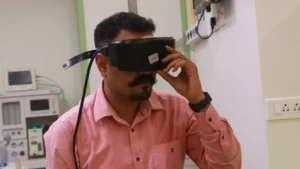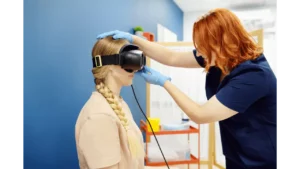Vestibular Rehabilitation: Help Vertigo Patients Regain Balance and Confidence
Dizziness, unsteadiness, and a spinning sensation are some of the incapacitating effects of vertigo. For those impacted, going about their everyday business becomes difficult. Thankfully, there is hope thanks to vestibular rehabilitation therapy, or VRT. The goals of this specific type of physical therapy are to improve balance, reduce vertigo symptoms, and improve quality of life in general. We’ll go over the specifics of VRT, its advantages, and how it aids people with vertigo in this blog post.
What is Vestibular Rehabilitation Therapy (VRT)?
A specialized exercise program called vestibular rehabilitation therapy aims to lessen vertigo symptoms and enhance balance. People with vestibular disorders—disorders affecting the inner ear and brain regions in charge of balance and eye movements—benefit most from it.
Key Components of VRT
- Assessment and Diagnosis: A thorough assessment by a healthcare professional to determine the specific cause and severity of the vestibular disorder.
- Customized Exercise Plan: Development of a tailored exercise regimen aimed at addressing the patient’s unique needs and symptoms.
- Progress Monitoring: Regular evaluation and adjustment of the exercise plan to ensure optimal outcomes.
How VRT Works

The way vestibular rehabilitation therapy operates is by rewiring the brain to more efficiently process vestibular system signals. This neuroplasticity process lessens the feeling of vertigo by assisting the brain in adjusting to changes.
Types of Exercises in VRT
- Gaze Stabilization Exercises: These exercises improve control of eye movements and enhance visual stability during head movements.
- Balance Training: Activities designed to improve overall balance and reduce the risk of falls.
- Habituation Exercises: Gradual exposure to specific movements or environments that trigger vertigo to help reduce sensitivity over time.
Benefits of Vestibular Rehabilitation Therapy

Image Source: Canva
Patients with vertigo can benefit greatly from VRT, which can help them restore their independence, confidence, and balance.
Reduction in Vertigo Symptoms
A major decrease in vertigo symptoms is one of the main advantages of VRT. Patients can have fewer and milder episodes of imbalance and dizziness with tailored workouts.
Improved Balance and Coordination
VRT improves brain adaptability and the vestibular system, which in turn improves balance and coordination. This is essential to guaranteeing safety when engaging in daily activities and preventing falls.
Enhanced Quality of Life
It can be upsetting and restrictive to have vertigo. With the support of VRT, patients can resume their confidence and participate in activities they had previously shied away from out of concern for vertigo episodes. For patients and their families, this increase in quality of life is priceless.
Reduced Dependence on Medication
Medication side effects are common, even if it can help control vertigo symptoms. By providing a non-pharmacological method, VRT helps minimize the hazards and dependency on drugs.
Who Can Benefit from Vestibular Rehabilitation Therapy?
Many different people with vestibular issues benefit from VRT. The following are common conditions treated with VRT:
Benign Paroxysmal Positional Vertigo (BPPV)
BPPV is a common cause of vertigo, characterized by short bursts of vertigo brought on by head movements. The severity and frequency of these episodes can be successfully decreased by VRT.
Vestibular Neuritis and Labyrinthitis
These disorders cause inflammation in the inner ear, which can cause abrupt, intense vertigo. By encouraging central compensation, VRT speeds up patients’ recuperation.
Meniere’s Disease

Image Source: Canva
Meniere’s illness is characterized by recurring episodes of vertigo, tinnitus, hearing loss, and fullness in the ears. VRT can aid with balance improvement and vertigo episode management.
Migrainous Vertigo
Vertigo can occasionally accompany migraines. When paired with effective migraine management techniques, VRT can greatly reduce symptoms.
The VRT Process: What to Expect

Image Source: Canva
Initial Assessment
A thorough evaluation by a vestibular specialist or physical therapist precedes the VRT procedure. A thorough medical history, balance tests, and assessments of eye movements and gait are all part of this evaluation.
Customized Treatment Plan
The therapist creates a personalized treatment plan based on the assessment, taking into account the unique requirements of the patient. A range of activities intended to address the difficulties noted are included in this plan.
Regular Therapy Sessions
Patients usually go to treatment on a regular basis, working with their therapist to complete the exercises that have been recommended. Depending on the patient’s development and the severity of the condition, these sessions vary in length and frequency.
Home Exercise Program
Patients frequently receive at-home exercises in addition to in-clinic appointments. To get the maximum effects from these exercises, consistency is essential.
Progress Monitoring and Adjustments
The therapist keeps a close eye on the patient’s development during the VRT program. The workout regimen is modified as necessary to guarantee ongoing progress.
Conclusion
Patients suffering from vertigo can benefit greatly from vestibular rehabilitation therapy (VRT), which is a very successful treatment that has been shown to lessen symptoms, restore balance, and improve quality of life. With the use of habituation exercises, balance training, and gaze stabilization, VRT assists patients in regaining their self-assurance and independence.
VRT can offer a road to recovery whether you or a loved one is coping with vestibular neuritis, Meniere’s disease, BPPV, or another vestibular ailment. Patients with vertigo can take charge of their illness and improve their quality of life by collaborating with a professional therapist and adhering to a personalized fitness regimen.
Speak with a medical professional or a vestibular specialist for further details about VRT and how it can treat vertigo. They can provide you individualized direction and assistance to aid in your recuperation.
FAQ’s
What is vestibular rehabilitation therapy (VRT)?
– Vestibular rehabilitation therapy (VRT) is a specialized, exercise-based therapy designed to alleviate problems caused by vestibular disorders. It is a customized set of visual and physical therapies tailored to the individual patient’s situation.
What are the goals of VRT?
– The goals of VRT are to enhance gaze stability, and postural stability, improve vertigo, and improve activities of daily living. VRT facilitates vestibular recovery mechanisms such as vestibular adaptation, substitution by other eye-movement systems, and habituation.
What are the key exercises for VRT?
– Key exercises for VRT include head-eye movements with various body postures and activities, maintaining balance with a reduced support base with various orientations of the head and trunk, and repeating movements that provoke vertigo. These exercises help retrain the body, brain, inner ear, and eyes to properly communicate.
How does VRT help vertigo patients?
– VRT helps vertigo patients by promoting vestibular adaptation and substitution, which can alleviate symptoms such as dizziness, loss of balance, and nausea. It also helps patients develop strategies to manage their vertigo and improve their overall quality of life.
Is VRT effective for all types of vertigo?
– VRT is effective for patients with stable vestibular lesions, regardless of age, cause, or symptom duration and intensity. It is also indicated for patients with central lesions or mixed central and peripheral lesions, head injuries, and psychogenic vertigo.
How often should VRT exercises be performed?
– Patients should perform VRT exercises several times daily, with each exercise performed at least twice per day, beginning with five repetitions and increasing to ten repetitions.
Can VRT be modified for different conditions?
– Yes, VRT exercises can be modified by performing them under various conditions, such as with different body postures, eye movements, and sensory deprivation.
How long does VRT typically take to show results?
– VRT typically takes several weeks to several months to show significant results, depending on the individual patient’s condition and response to treatment.
Is VRT safe?
– VRT is generally considered safe when performed under the guidance of a trained therapist. However, patients should be monitored during treatment sessions, and safety precautions should be taken to avoid falls and other injuries.
Can VRT be used in conjunction with other treatments?
– Yes, VRT can be used in conjunction with other treatments such as medications, physical therapy, and lifestyle changes to provide comprehensive management of vertigo symptoms.
